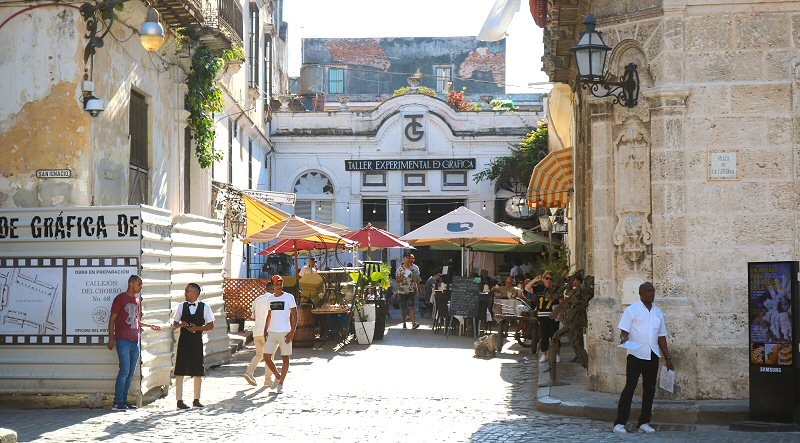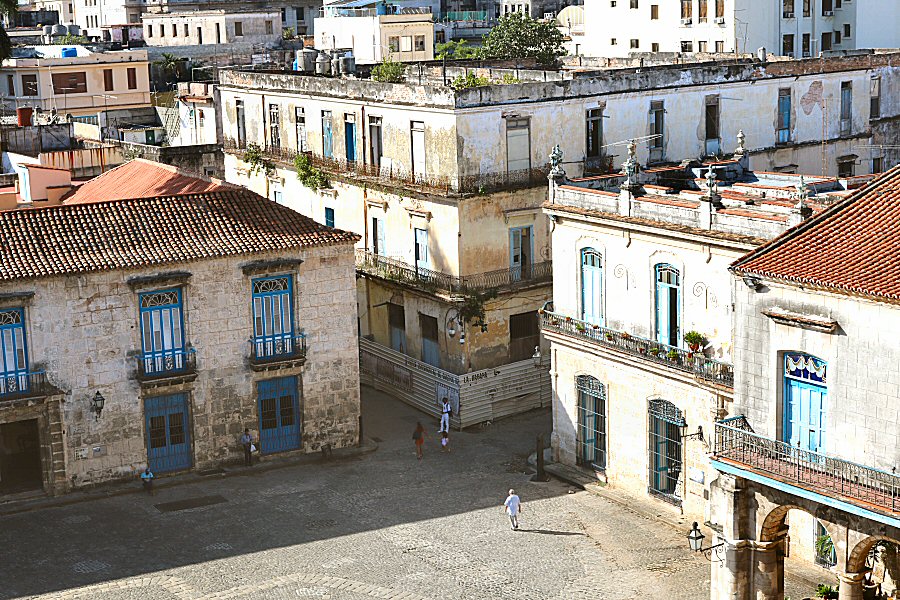
The Callejón del Chorro is a short cul-de-sac of about 30 meters at the southwest corner of the Plaza de la Catedral.
Before the 18th century
the current Callejón del Chorro was a continuous street from
the San Ignacio street up to the Compestala street,
interrupted only by small wooden bridges that were built to
bypass the ditch. The water channel was running ran through the areas that later
became the crowded streets of Havana, like the Cuba, the
Aguiar and the Havana streets.
Formerly, the name of the
open street was Jagüey (means, ditch filled with water).
The name of Jagüey must have been given to the street because
of the cistern, built by order of the Governor and the
Captain General Gabriel de Luján in 1587 to collect the
water of the springs around. The abundant water was used to
supply the Spanish fleet docking in Havana and for other
purposes. When the Jagüey street was closed, the cul-de-sac
was named the Callejón del Chorro, referring
to the Almendares river that was called by the first
Spaniards as La Chorrera, or popularly known just
as Chorro. The Zanja Real (Royal Ditch) was the
first water channel of Havana, built in 1592 to bring the
water of the Almendares river to the city. Thus, the
water of the Almendares river started to supply the plaza
through an open hole at the wall of the first house on the
right side of the current Callejón del Chorro where the
public bath house (Casa de Baños) was opened later.
The water that reached the
Jagüey street, was accumulated first in the cistern to
facilitate the access to the water by the consumers, and
then continued towards to the sea, crossing the current
Plaza de la Catedral and El Boquete. El Boquete is the
opening at the city wall at the beginning of the Empedrado
street that took its name from the surname of the family
Boquete de los Piminta that lived nearby. A section of the
water channel that was going through the square, was brought
to light during the excavations in the Casa del Marqués de
Arcos and covered with plate glass for the visitors.
In the 16th century the
Plaza de Ciénaga (current Plaza de la Catedral) had two important sources of water: the
water of the springs around the area that were the first
public water source, located intramural, and the water
coming from the channel of the Zanja Real that was
extramural. They were feeding the same cistern that was
built at the corner of the Jagüey street where the Victor
Manuel Galllery stands today.
Victor Manuel
García Valdez (1897-1969) was a Cuban
painter, one of the early members of the Vanguardia movement
of artists, as well as one of the initiators of the modern
art in Cuba. His gallery is located in the San Ignacio
street #56 (former #18), occupying the former Casa de
Baños (Public Bath) that was built over the cistern. It was
the first public bath house in Havana. The
Victor Manuel Galllery offers a wide selection on mainstream
decorative modern paintings.
In 1596, a stone plaque was placed on the wall of the Victor Manuel Galllery looking to the Calejón del Chorro and a stone monument at the corner of the house. Even though the wall was rebuilt in 1854, great care was taken to mount them to their original place. They are still preserved and evoke the function of the place by the inscription on the wall that was installed by Juan de Texeda: En este Callejón del Chorro derramaba la Zanja que surtia de agua a la ciudad en el año 1592 como su unico acueducto (In this Callejón del Chorro it poured the Ditch that supplied water to the city in 1592 as its only aqueduct). Juan de Texeda (or Tejeda) was the Governor and the Captain General of Cuba that built the Zanja Real. On the stone monument it is written in old Castilian language: Esta agua traxo el Maesse de Campo Jvan de Texada anno de 1592. (This water was traversed by the Field Master Juan de Texada in the year of 1592). Below the inscription there is a face carved in marble. As you will imagine, water was gushing out through its mouth in the past.
The Jagüey street was
closed by a house, converting it into a cull de sac, called
Callejón del Chorro. This house that was the oldest
of the three houses that made up the alley, was demolished
in 1910, and replaced by the building that occupies the
Taller Experimental de Gráfica (Experimental
Graphics Workshop) today. Paladar Doña Eutemia, one
of Cuba’s first paladares (private home restaurants), is on
the right side just before the workshop, and the Dulceria
Bianchini II on the left. Thus, on the cobblestoned alley
one can taste the Cuban dishes and pastry, buy works of art
or enjoy live music, played by a young guitarist.


